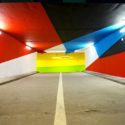“Using Painting for Sculptural Purposes” is Argentinian artist Elian Chali‘s newest piece, painted for the “2km3_Saint Gervais Project” curated by Hugues Chevallier and Zoer in Saint Gervais, Montblanc, France.
The project also featured the participation of artists such as Roids, Velvet, Swiz, Sobekcis, Sten & Lex, SatOne, Etienne de Fleurieu, Jaw DMV and Felipe Pantone, who covered an entire parking lot with extraordinary pieces.
As explained by Elian, “the main feature of sculpture is the relationship with its spatial environment and the ability to modify it.” Using basic geometry and primary colours, as well as the surrounding architecture to create space, the new work was conceived with the intention of using painting as a space creating tool where each element adopts a new function, transforming in this way the painted space into a huge sculpture. By painting the whole space, from floor to ceiling, the work gives the viewer the opportunity to immerse themselves in the work in what he calls “an unexpected encounter with creativity.”
About the artist
Born and raised in Córdoba, Argentina where he currently works and lives, Elian has developed through the years a highly recognisable and unique style. His work focuses on creating a dialogue with the urban structures he paints as well as their surroundings, allowing the characteristics of each wall become part of the work This is probably the reason why he identifies himself more with urbanism and architecture than with muralism and graffiti.
According to Elian, his goal is to create a range of easily recognisable colours that don’t fade with the passage of time. His choice of working with primary colours is also linked to a wish to simplify his work as much as possible bringing it to a minimum, both in terms of colours and shapes.
Images by Elian. Video by German Rigol.
More about Elian on: Website | Instagram | Facebook
Author: Fran
Founder and editor of Urbanite. Street Art lover who after the finishing her MA thesis on the Mexican and Norwegian muralist movement in the 1920-50s, developed a fascination for street art and graffiti that eventually led to collaborations with different art blogs, including the creation of this one.








You must be logged in to post a comment.